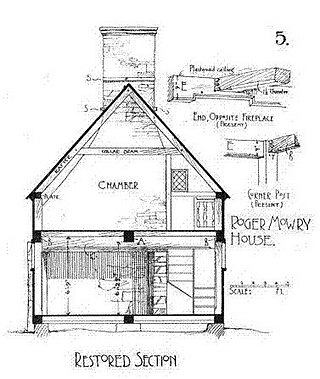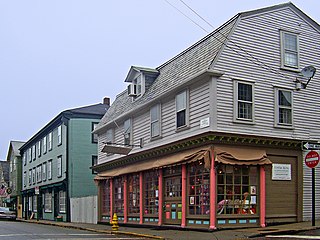


The Goddard and Townsend families of Newport lend their name to an extensive body of New England furniture associated with Newport, Rhode Island in the second half of the 18th century.



The Goddard and Townsend families of Newport lend their name to an extensive body of New England furniture associated with Newport, Rhode Island in the second half of the 18th century.
The Townsend and Goddard families were two Quaker families that were part of a large cabinetmaking community centered in The Point neighborhood of Newport, a predominantly Quaker neighborhood. The founders of this cabinetmaking dynasty immigrated to Newport from other New England towns. Christopher Townsend (1701–1787) and Job Townsend (1699–1765) of Oyster Bay, New York, came to Newport in 1707 with their parents Solomon Townsend and Catherine (Almy) Townsend. Both brothers would become cabinetmakers in Newport. Carpenter and cabinetmaker Daniel Goddard (1697–1764) was born in Jamestown, Rhode Island to Henry Goddard and Mary (Howland) Goddard. He moved from Jamestown first to Dartmouth, Massachusetts, before settling in Newport by 1727.
The second generation of Newport cabinetmakers from these families are perhaps the best known. John Townsend (1732–1809) was the son of Christopher Townsend and Patience (Easton) Townsend. He would marry Philadelphia Feke (1742–1802), daughter of famed portrait painter Robert Feke. John Goddard (1723/4-1785) was the son of Daniel Goddard and apprentice of Job Townsend. He married Job's daughter Hannah Townsend (1728–1804). [1]
Twenty-one members of successive generations of these two intermarried families worked as cabinetmakers over a period of 120 years, selling their products not only in New England but also in the coastal trade and in the West Indies. [2]
The furniture associated with the Goddard and Townsend families is identified by a number of unique features. The so-called Block-and-shell motif, a block-front topped by a carved shell in alternating concave and convex pattern, is one of the key features. However, this alone is not proof of Goddard or Townsend origin- recently rediscovered cabinetmakers such as Benjamin Baker (1734–1822) of Newport or Grindal Rawson (1719–1803) of Providence are also known to have used the carved shell pattern when constructing case furniture. [3] Newport furniture of this school is also associated with a distinct ball and claw foot, in which there is an open space carved between the talon and ball. Such a form is thought to be unique to Newport, though not unique to the Goddard or Townsend families.
A single mahogany secretary bookcase made by Christopher Townsend (John's father) in 1740 sold at auction in New York for $8.25 million. John Goddard made a famous six-shell desk-bookcase for Providence merchant Nicholas Brown, Sr. It was sold by the Brown family in 1989, for $12.1 million — a record for a piece of American furniture at auction. The Museum of Fine Arts, Houston, Philadelphia Museum of Art, Metropolitan Museum of Art, Boston Museum of Fine Art, Yale University Art Gallery, Rhode Island School of Design Museum of Art and Preservation Society of Newport County own works of Goddard-Townsend.

Jamestown is a town in Newport County, Rhode Island in the United States. The population was 5,559 at the 2020 census. Jamestown is situated almost entirely on Conanicut Island, the second largest island in Narragansett Bay. It also includes the uninhabited Dutch Island and Gould Island.

John Brown I was an American merchant, politician and slave trader from Providence, Rhode Island. Together with his brothers Nicholas, Joseph and Moses, John was instrumental in founding Brown University and moving it to their family's former estate in Providence.

Samuel Ward was an American farmer, politician, Rhode Island Supreme Court justice, governor of the Colony of Rhode Island and Providence Plantations, and delegate to the Continental Congress where he signed the Continental Association. He was the son of Rhode Island Governor Richard Ward, was well-educated, and grew up in a large Newport, Rhode Island, family. After marrying, he and his wife received property in Westerly, Rhode Island, from his father-in-law, and the couple settled there and took up farming. He entered politics as a young man and soon took sides in the hard-money vs. paper-money controversy, favoring hard money or specie. His primary rival over the money issue was Providence politician Stephen Hopkins, and the two men became bitter rivals—and the two also alternated as governors of the colony for several terms.
Nicholas Brown Sr. was an American slave trader and merchant who was a co-signer of the founding charter of the College of Rhode Island in 1763. In 1771, Nicholas Brown Sr. was instrumental in convincing Baptist authorities to locate a permanent home for the College in his hometown of Providence. In 1804, the College was renamed Brown University following a gift made by Brown's son Nicholas Brown Jr.

Hunter House (1748) is a historic house in Newport, Rhode Island. It is located at 54 Washington Street in the Easton's Point neighborhood, near the northern end of the Newport Historic District.

Benedict Arnold was president and then governor of the Colony of Rhode Island and Providence Plantations, serving for a total of 11 years in these roles. He was born and raised in the town of Ilchester, Somerset, England, likely attending school in Limington nearby. In 1635 at age 19, he accompanied his parents, siblings, and other family members on a voyage from England to New England where they first settled in Hingham in the Massachusetts Bay Colony. In less than a year, they moved to Providence Plantation at the head of the Narragansett Bay at the request of Roger Williams. In about 1638, they moved once again about five miles (8 km) south to the Pawtuxet River, settling on the north side at a place commonly called Pawtuxet. Here they had serious disputes with their neighbors, particularly Samuel Gorton, and they put themselves and their lands under the jurisdiction of Massachusetts, a situation which lasted for 16 years.

Jabez Bowen, Sr. was an American shipper, slave trader and politician. He was a militia colonel during the American Revolutionary War, and served as Deputy Governor of Rhode Island and chief justice of the Rhode Island Supreme Court.

The Newport Restoration Foundation was founded by Doris Duke in 1968 in Newport, Rhode Island to preserve early housing stock including 18th century colonial homes. Former First Lady Jacqueline Kennedy Onassis was the foundation's vice president.

The Whitehorne House is an example of a United States Federal style mansions at 416 Thames Street in Newport, Rhode Island and is open to the public as a historic house museum.

The Museum of Art, Rhode Island School of Design is an art museum integrated with the Rhode Island School of Design, in Providence, Rhode Island, US. The museum was co-founded with the school in 1877, and still shares multiple buildings and facilities. It is the 20th-largest art museum in the United States, and has seven curatorial departments.

Smith's Castle, built in 1678, is a house museum at 55 Richard Smith Drive, near Wickford, a village in North Kingstown, Rhode Island. Smith's Castle is one of the oldest houses in the state. It was designated a National Historic Landmark in 1993 as Cocumscussoc Archeological Site due to the artifacts and information that digs have yielded in the area. It is located just off U.S. Route 1 in Rhode Island.

Norman Morrison Isham (1864–1943) was a prominent architectural historian, author, and professor at Brown University and Rhode Island School of Design (RISD). He was an ardent preservationist and a pioneer in the study of early American architecture.

The Point is one of the oldest neighborhoods in Newport, Rhode Island and has one of the highest concentrations of colonial houses in the United States. The neighborhood sits between Washington Street and Farewell Street/America's Cup in Newport looking out on Goat Island, former home to the U.S. Naval Torpedo Station.

The Newport Historic District is a historic district that covers 250 acres in the center of Newport in the U.S. state of Rhode Island. It was designated a National Historic Landmark (NHL) in 1968 due to its extensive and well-preserved assortment of intact colonial buildings dating from the early and mid-18th century. Six of those buildings are themselves NHLs in their own right, including the city's oldest house and the former meeting place of the colonial and state legislatures. Newer and modern buildings coexist with the historic structures.

Daniel Pabst was a German-born American cabinetmaker of the Victorian Era. He is credited with some of the most extraordinary custom interiors and hand-crafted furniture in the United States. Sometimes working in collaboration with architect Frank Furness (1839–1912), he made pieces in the Renaissance Revival, Neo-Grec, Modern Gothic, and Colonial Revival styles. Examples of his work are in the collections of the Metropolitan Museum of Art, the Philadelphia Museum of Art, the Art Institute of Chicago, and the Victoria and Albert Museum in London.
Ralph Emerson Carpenter Jr. was a conservationist, Colonial furniture expert and author. A descendant of the noted Carpenter founding family of colonial Rhode Island, for more than a half century, he was actively involved in the restoration of some of Newport, Rhode Island's defining structures.
John Townsend was an early settler of the American Colonies who emigrated from England before 1642 when his son, Thomas, was baptized at the Dutch Reformed Church in New Amsterdam. Townsend was a signatory to the Flushing Remonstrance, a precursor to the United States Constitution's provision on freedom of religion in the Bill of Rights. Because of their persecution by the Dutch authorities of New Amsterdam, he and his brother Henry supported the Quakers, and later generations of this Townsend family joined the movement. They can be found in Friends' records on Long Island, New York, Newport, Rhode Island, Cape May County, New Jersey and around Philadelphia. There is no evidence in either Warwick, Rhode Island or New York sources that John was a Quaker himself. John Townsend arrived in Oyster Bay in 1661 and he died there in 1668. There is a marker for him in Fort Hill Cemetery in the village of Oyster Bay. Members of his family would go on to be distinguished leaders in the Oyster Bay community, throughout New York State, the mid-Atlantic colonies and wherever they settled in the rest of the United States. The talented and famous furniture makers of Newport, Rhode Island Job, Christopher, John and Edmund descend from him.
Henry Bull (1610–1694) was an early colonial Governor of Rhode Island, serving for two separate terms, one before and one after the tenure of Edmund Andros under the Dominion of New England. Sailing from England as a young man, Bull first settled in Roxbury in the Massachusetts Bay Colony, but soon became a follower of the dissident ministers John Wheelwright and Anne Hutchinson, and was excommunicated from the Roxbury church. With many other followers of Hutchinson, he signed the Portsmouth Compact, and settled on Aquidneck Island in the Narragansett Bay. Within a year of arriving there, he and others followed William Coddington to the south end of the island where they established the town of Newport.

Rosanne Somerson is an American-born woodworker, furniture designer/maker, educator, and former President of Rhode Island School of Design (RISD). An artist connected with the early years of the Studio Furniture, her work and career have been influential to the field.

Thomas Poynton Ives was an American merchant and banker from Rhode Island.